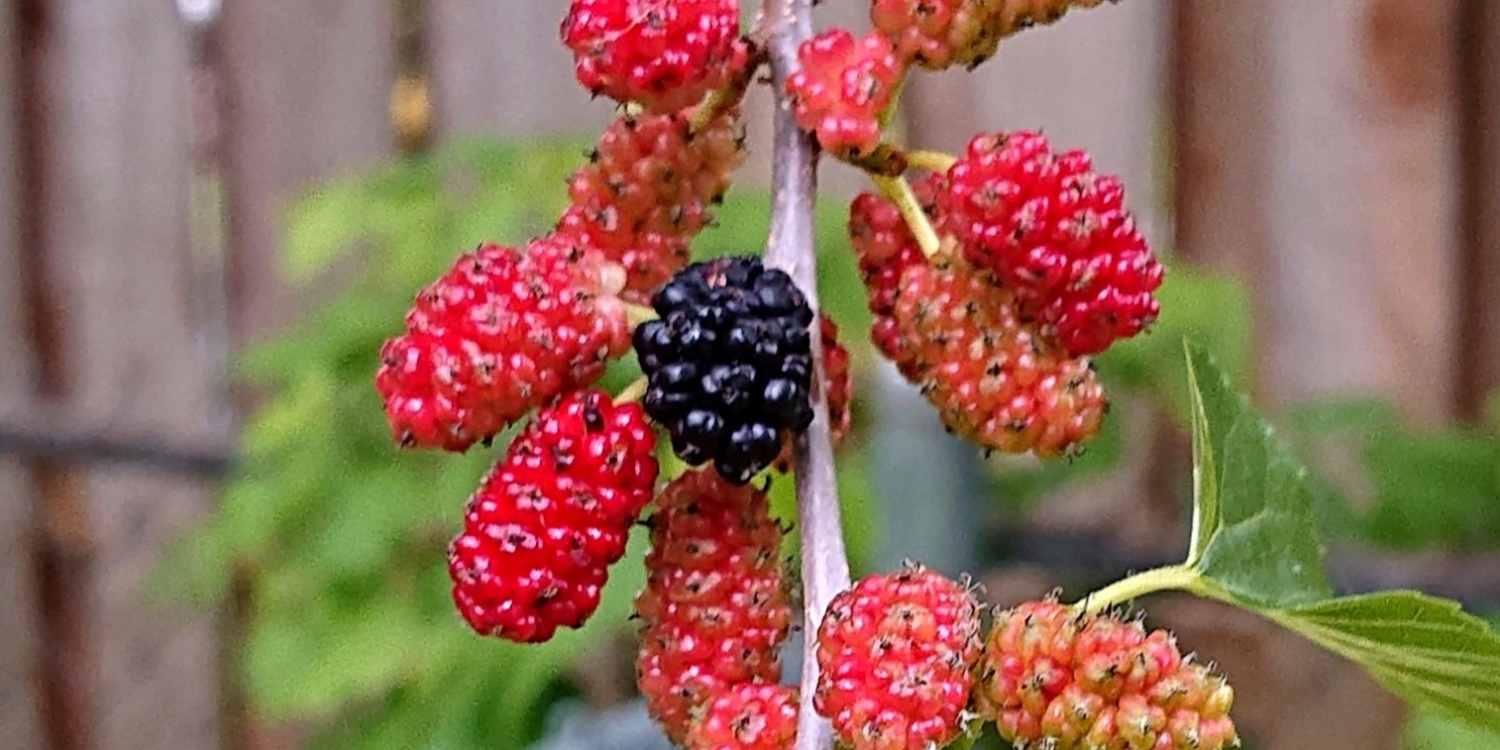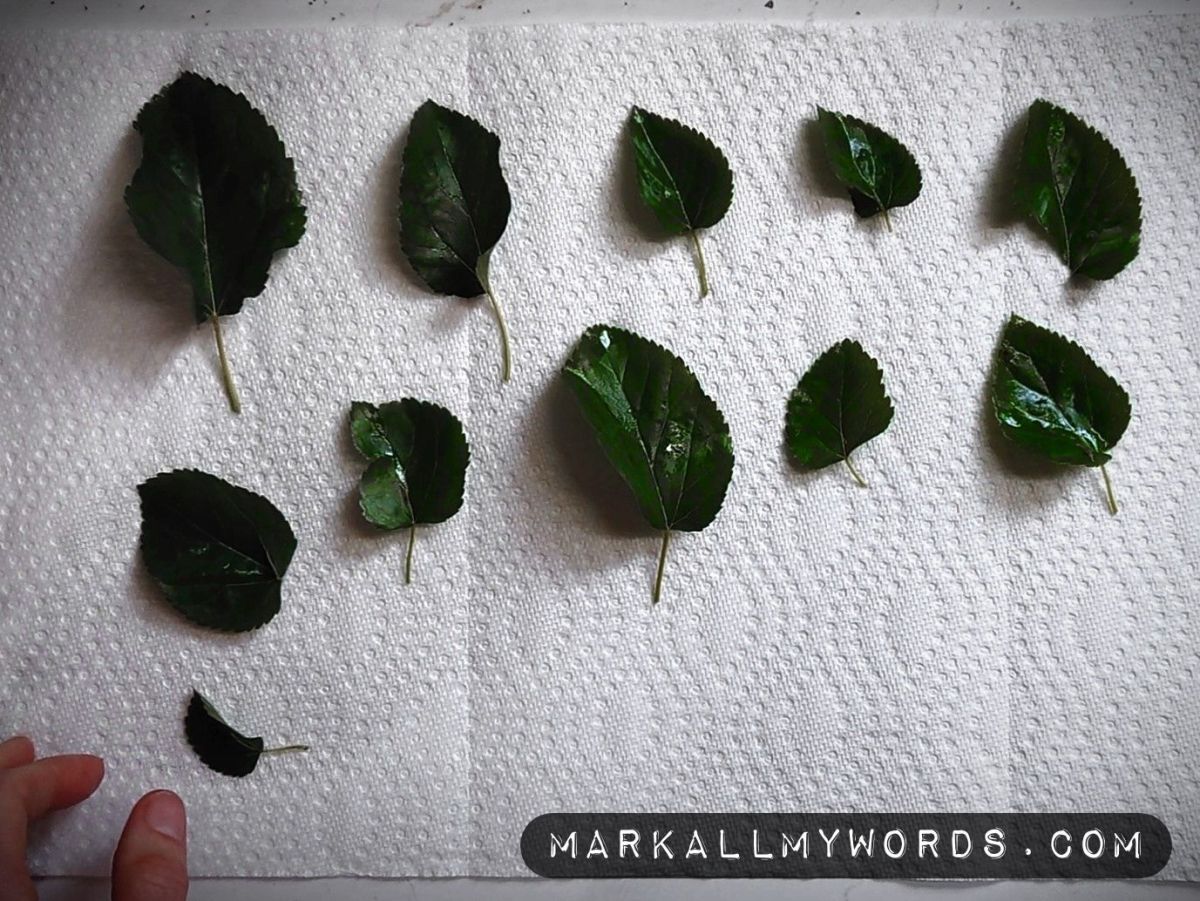
Now that it’s the end of May, mulberries (Morus spp.) are falling off the branch here in central North Carolina. In fact, they’ve been falling off the branch for the past three weeks, since the beginning of May, in yet another display of the ongoing effects of climate collapse. (For the record, mulberries don’t typically start to ripen in this region until the end of May.)
With a wide range of nutrients, uses, and benefits, the red mulberry is a wonder of a tree. Not only are the berries edible and medicinal, but they may even be mildly anti-carcinogenic, for reasons that I will cover in this article. In addition, the leaves, branches, and roots are medicinal as well, with benefits to the heart and blood in particular.
(As a matter of clarification, the mulberry trees in my region are most likely a hybrid between red mulberry (M. rubra), a native species, and white mulberry (M. alba), an introduced species. As such, I will be including information in this article which pertains to both species, even as I primarily discuss red mulberry.)
Overview
Red mulberry is a native species of the eastern United States, with a range that extends from Ontario in the north to Florida in the south. It can tolerate a wide range of soil and climatic conditions, including protracted periods of hard freeze and high heat, heavy rainfall and drought. In addition, it has very few pests or predators, making it one of the hardiest and most bountiful fruit trees in the eastern United States.
Capable of growing up to seventy feet in height, though generally only reaching about forty feet, the red mulberry has soft wood with reddish-brown bark that starts out fairly smooth and becomes progressively more ridged and rough with age.

This bark in turn oozes a kind of latex when cut, thereby protecting the tree from excessive predation and allowing any injured tissue to seal and heal quickly.
While the latex is unpalatable to most species, the leaves most certainly are not, as they are a favorite food source of silkworms (Bombyx mori) and livestock. Measuring up to six inches long by four inches wide, mulberry leaves vary in color from bright yellowish-green to deep green. They are alternate, hairy on both sides, toothed, and occasionally lobed.

One of the most confusing aspects of mulberry leaves is in fact their lobes. The reason for confusion is that mature trees frequently have no lobes at all while immature trees may have as many as five. As a result, the leaves of an immature and mature tree may appear to be from entirely different species.
Also easy to confuse with a different species is the mulberry itself, which can reach up to two inches in length and a half inch in width — though it’s usually about an inch long by a quarter inch wide.

Looking for all the world like a blackberry in a tree, the mulberry fruit can be distinguished from its lookalike by virtue of the tree that bears it and by the absence of thorns on the stems surrounding it. In addition, the blackberry is a compound fruit, meaning that it grows from several different ovaries on a single flower. Whereas, by contrast, the mulberry is a multiple fruit, meaning that it grows from several different flowers on the same stalk — all of which grow together and merge as they ripen.
Nutrition
[Before harvesting or consuming wild plants, make sure you have the permission of the landowner and an understanding of considerations for use.]
After ripening, mulberries are ready to be eaten. With a taste reminiscent of blackberries, they are very sweet and occasionally sour, depending on their level of ripeness. Though they have floral undertones, their taste is not as distinctive as that of many other fruits, and it may be easy to overlook them as a result.
Even so, their nutritional content is quite impressive. With plentiful amounts of vitamin C, vitamin K, iron, and anthocyanidin, mulberries are nutritional powerhouses. Vitamin K and iron in particular are good for the blood, since the former helps to prevent internal bleeding and the latter facilitates the transport of oxygen. Anthocyanidin, in turn, are strong antioxidants, which neutralize free radicals and help to stop the growth of cancer.
And, as it turns out, it’s not merely the fruits that are nutritional powerhouses; the leaves are as well, in addition to being mildly tasty.

Containing vitamin C, vitamin K, beta carotene, zinc, calcium, and iron, mulberry leaves have a wealth of micronutrients that are necessary for human health. Like anthocyanidin, beta carotene is another strong antioxidant, which also helps to keep hair, nails, and eyes healthy. Zinc and calcium contribute to growth and development and bone health, respectively.
And then there’s deoxynojirimycin. This dauntingly named alkaloid has some of the impressive health effects of any substance in the mulberry genus. First of all, it has a suppressant effect on blood sugar, slowing the effective digestion of carbohydrates and reducing the rate at which glucose is absorbed into the bloodstream. Beyond that, it reduces LDL cholesterol levels and increases HDL cholesterol levels, slowing the formation of plaque and reducing risks associated with atherosclerosis.
Other Uses
And, as if that weren’t enough, mulberries also have a number of other uses, from culinary and medicinal to industrial and ecological.

On a culinary level, one of the simplest uses is mulberry syrup, which can be made by mashing the berries, boiling them with water and sugar, and straining the resulting mixture. Similar to this is mulberry jam, which differs from syrup by the reduction in water content and addition of pectin, a thickening agent. And then there’s mulberry wine, which differs from syrup by the addition of a live culture and by the time required for fermentation.
On a medicinal level, the leaves have been used in the past as a diaphoretic (inducing sweating and excretion through the skin) to treat fever, flu, and dysentery. The branches have been used as an antispasmodic (primitive muscle relaxant) to relieve symptoms of rheumatism and arthritis. The root has been used as an expectorant (reducing accumulation of mucus and phlegm) to treat cough, wheezing, and edema. And finally the fruits have been used as a tonic (general adjunct to health) to treat anemia, insomnia, and graying hair.
On an industrial level, the fruits have been used to make a powerful magenta dye, requiring the addition of water and alum and extensive boiling time. The inner lining of the bark has been used historically by Native Americans to make a kind of primitive cloth and in the ancient Khmer empire to make a kind of durable paper — some of which exists to this day despite being manufactured many centuries ago.
Finally, on an ecological level, mulberries provide an abundant food source for wildlife of many different kinds, especially birds like the robin, mockingbird, grackle, and cedar waxwing. In fact, cedar waxwings depend on it as one of their primary food sources, appearing and disappearing in large flocks seemingly at random to feast on the small, sweet berries.
Value
On this basis, it shouldn’t be hard to appreciate the value of red mulberry in particular and the entire mulberry family in general. Not only is it a powerful ally of health, an abundant source of food and medicine, and a giver of the basic necessities of life. As with all of nature, it is an example of how we should live.
For mulberry teaches us the value of resilience, good health, and giving. It shows that we must withstand life’s difficulties, look after ourselves, and give back to others. It shows us that life is about more than simply who can win; it’s about who can give, freely and generously, to all in need.
And that’s a lesson we can all learn from.
I have a fruiting mulberry that was a volunteer, now it’s huge. In SoCal. Thanks for the tips on all the uses I wasn’t aware of.
LikeLiked by 1 person
I have one of these in my backyard. Now I finally know what to call it. Thanks!
LikeLiked by 2 people
Thank you for this very interesting focus on a quite neglected tree, we still have old and almost forgotten mulberry trees in some areas of the South of France too, because silkworms used to be farmed there quite intensively in the 19th century, but I learnt a lot of things about this tree from your article.
LikeLiked by 2 people
Love them…not ripening here until July…Oh Canada. 😒
LikeLiked by 2 people